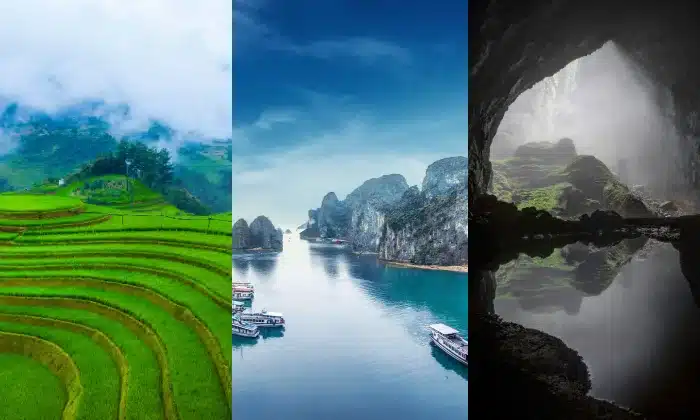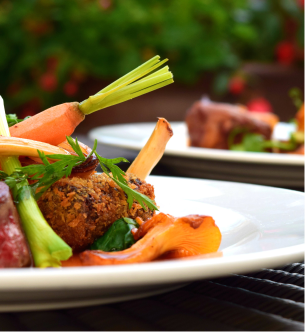Discover the breathtaking beauty of three natural wonders in Vietnam such as the Mu Cang Chai rice terraces, the breathtaking beauty of Ha Long Bay and the world’s largest cave Son Doong. Vietnam landscapes are rich of mountains that hug the clouds and white sand beaches and turquoise water to black rock forests.
Vietnam travel: Find best places to travel
There are plenty of tourist attractions in Vietnam but we will cover 3 special spots that are unreal in terms of natural beauty. There are many Vietnam cities to be explored but these 3 are wonders.
Mu Cang Chai rice terraces
Discover the breathtaking beauty of the Mu Cang Chai rice terraces in Vietnam. Discover the traditional farming techniques used to cultivate these stunning landscapes and explore the cultural significance of rice cultivation in this region with the rolling hills and lush green fields of Mu Cang Chai which is one of the most spectacular sights in Asia.
Mu Cang Chai is a rural district in the Yen Bai province of northern Vietnam. It’s renowned for its stunning landscapes, particularly its terraced rice fields. The terraces in Mu Cang Chai are not only breathtakingly beautiful but also serve as an essential part of the local ethnic minorities’ agricultural practices.
You will be met with the captivating sight of terraced rice fields that flow down the hillsides like enormous steps as soon as you set out on your tour. Over generations, the H’mong, Thai, and Dao people, among other ethnic minority groups in the area, have painstakingly sculpted these elaborate terraces into the surrounding landscape.
The inventiveness and tenacity of the indigenous farmers are demonstrated by the traditional farming methods employed in Mu Cang Chai. They farm the land using age-old techniques that have been passed down through the generations because they have limited access to modern agricultural technology. The fields are still often plowed by hand tools and water buffalo, and rice seedlings are laboriously replanted by hand.
However, Mu Cang Chai is unique not just because of its farming methods but also because of the cultural importance of rice growing in this area. Here, rice is more than simply a crop—it’s a way of life. It is the foundation of the regional economy and is essential to the communities’ sense of cultural identity in Mu Cang Chai.
Rice is more than simply sustenance to the inhabitants of Mu Cang Chai; it also represents wealth, fertility, and abundance. Every year, during the rainy season, the rice fields fill with water, transforming the surrounding area into an ocean of green that reflects the sky above in an amazing exhibition of the beauty of nature.
Mu Cang Chai offers an incredible experience that will leave you in wonder of the utmost beauty of nature and the resiliency of the human spirit, whether you’re a nature lover, an avid photographer, or someone just looking for a deeper connection with the land.
Here’s some more information about the Mu Cang Chai rice terraces:
Scenic Beauty: The terraced rice fields of Mu Cang Chai are known for their picturesque beauty, especially during the rice-growing season. The landscape transforms into a vibrant green canvas as the terraces fill with water and young rice plants.
Cultural Significance: The terraced rice fields in Mu Cang Chai are a testament to the inventiveness and agricultural traditions of the surrounding ethnic minority populations, in addition to being a natural wonder. Rice has been grown on these terraces for years by the H’mong, Thai, and Dao ethnic groups, who use age-old farming techniques that are passed down via families.
UNESCO Recognition: Although the Mu Cang Chai terraces are not formally listed as a UNESCO World Heritage Site, they are frequently taken into account when discussing the wider acknowledgement of Vietnam’s rice terrace culture. Mu Cang Chai is situated in the Hoang Lien Son range, which is on the preliminary list for UNESCO consideration.
Tourism: People who come to Mu Cang Chai to take in the natural beauty of the terraced rice fields are drawing more and more tourists to the area. Hiking, photography excursions, and engaging with local populations to get insight into their agricultural techniques and way of life are among the many activities available to tourists.
Seasonal Variations: Depending on the season, the Mu Cang Chai rice terraces have a different appearance. The months of May through October are usually the most breathtaking for viewing the scenery. The terraces are submerged in water during this period, resulting in breathtaking reflections of the sky and surroundings.
All things considered, the Mu Cang Chai rice terraces are not only a magnificent natural sight, but also evidence of the rich cultural history and environmentally friendly farming methods of the nearby ethnic minority populations in northern Vietnam.
Ha Long Bay
Welcome to Quang Ninh Province in Vietnam, home of Ha Long Bay, a UNESCO World Heritage Site of spectacular beauty. Ha Long Bay is well-known for its breathtaking limestone karst structures, emerald waters, and abundant wildlife. The name Ha Long Bay translates to “Descending Dragon Bay” in Vietnamese.
You will be met by a scene out of a fairy tale as soon as you set sail on the tranquil waters of Ha Long Bay. Travelers have been enthralled with the bizarre and otherworldly scenery that is created by thousands of limestone pillars and islets rising sharply from the water for millennia. Millions of years of geological processes have sculpted these karst structures, creating an incredible and distinctive landscape.
A top attraction when discovering Ha Long Bay is sailing through its intricate system of caverns and rivers, which resembles a maze. Take a ride on a classic junk boat and cruise by remote beaches, secret lagoons, and towering limestone cliffs. Admire the breathtaking natural arches and caverns scattered throughout the coast, each with a fascinating tale to tell.
Ha Long Bay is home to a wealth of species in addition to its breathtaking natural beauty. There is a wide variety of flora and fauna in the bay, including uncommon plant, bird, and marine species. Look out for secretive marine life such as the endangered Indo-Pacific humpback dolphin and the monkeys swinging through the trees, as well as vibrant coral reefs brimming with fish.
You will have the chance to fully immerse yourself in the history and culture of Ha Long Bay while you explore it. See floating fishing villages, where generations of people have continued to live according to mostly unchanging traditions.
Ha Long Bay provides lots of chances for people looking to de-stress and rejuvenate. Enjoy your days lounging on immaculate beaches, paddling a kayak through serene seas, or just taking in the breathtaking scenery from your boat’s deck. Settle back and enjoy the peace of this enchanted location as the sun sets.
Whatever your reason for visiting Ha Long Bay—its stunning natural surroundings, abundant wildlife, or rich cultural legacy—it promises to be an amazing experience that will enchant and inspire you.
One of Vietnam’s most famous natural wonders, Ha Long Bay is a UNESCO World Heritage Site that is situated in the Quang Ninh Province. Vietnamese legend translates its name as “Descending Dragon Bay.”
An examination of this magnificent location can be found here:
Geological Wonders: Ha Long Bay is well-known for its breathtaking scenery of limestone islets and karsts that rise sharply from the emerald waters of the Gulf of Tonkin. These karst formations have been shaped over millions of years by the erosive forces of wind and water, creating a labyrinth of over 1,600 islands and islets.
Spectacular Scenery: The bay’s towering limestone pillars, topped with lush vegetation, form a spectacular backdrop for exploration. Visitors can cruise through the bay on traditional junk boats or kayaks, marveling at the maze of cliffs, caves, and hidden lagoons along the way.
Cultural Heritage: Ha Long Bay is not only a natural wonder but also steeped in history and culture. It has been inhabited by various indigenous communities for thousands of years, and evidence of ancient human presence, including prehistoric tools and shell middens, has been discovered in the area.
Rich Biodiversity: The bay is home to a diverse ecosystem, with hundreds of plant and animal species, many of which are endemic to the region. Visitors can spot wildlife such as monkeys, lizards, and rare bird species while exploring the islands and caves of Ha Long Bay.
Cave Exploration: Ha Long Bay is dotted with numerous caves and grottoes, each with its own unique features and formations. Some of the most popular caves to explore include Thien Cung Cave, Sung Sot Cave, and Dau Go Cave, where visitors can admire intricate stalactites and stalagmites.
Outdoor Activities: In addition to cruising and cave exploration, Ha Long Bay offers a range of outdoor activities for adventure enthusiasts. Visitors can go swimming, snorkeling, rock climbing, or hiking on some of the larger islands, such as Cat Ba Island.
Sunset Magic: One of the most enchanting experiences in Ha Long Bay is watching the sunset over the karst formations, painting the sky with hues of orange and pink. It’s a magical moment that captures the timeless beauty and tranquility of this UNESCO World Heritage Site.
Ha Long Bay is a destination that captivates visitors with its natural beauty, cultural heritage, and serene atmosphere. Whether you’re seeking adventure or relaxation, this iconic destination offers an unforgettable experience that will leave you in awe of its magnificence.
Hang Son Doong
Hang Son Doong is the the world’s largest cave, located in the heart of the Phong Nha-Ke Bang National Park in Vietnam. Prepare to embark on an unforgettable adventure as we explore the wonders of this breathtaking natural marvel. Discover its breathtaking beauty, unique geological features, and rich biodiversity on this unforgettable adventure.
Here’s some more information about Son Doong
Unrivaled Size: Son Doong Cave is a colossal underground wonder, stretching over 9 kilometers (5.6 miles) in length, with sections reaching up to 200 meters (656 feet) in height and 150 meters (492 feet) in width. Its sheer size dwarfs all other known caves, making it a truly awe-inspiring spectacle.
Unique Geological Features: As we venture deeper into Son Doong, prepare to be mesmerized by its unique geological formations. Marvel at towering stalagmites and stalactites, formed over millions of years by the slow drip of mineral-rich water. Encounter vast underground rivers, turquoise pools, and surreal limestone formations that defy imagination.
Enchanting Biodiversity: Despite its subterranean location, Son Doong is teeming with life. The cave harbors a rich biodiversity, with unique species of flora and fauna adapted to its dark and humid environment. Keep an eye out for rare cave-dwelling creatures such as blind fish, cave crickets, and albino shrimp as we explore the cave’s hidden corners.
Majestic Chambers: Son Doong is home to several majestic chambers that leave visitors in awe of their grandeur. One of the most famous is the “Hand of Dog” chamber, named for its resemblance to a giant dog’s pawprint. Other notable chambers include the “Watch Out for Dinosaurs” chamber, with its towering limestone columns, and the “Garden of Edam” chamber, adorned with lush vegetation.
Challenging Expedition: Exploring Son Doong is not for the faint of heart. The journey to reach the cave involves trekking through dense jungle, crossing rivers, and navigating rugged terrain. Once inside, adventurers must traverse rocky passages, wade through underground rivers, and scale steep cliffs. But for those willing to take on the challenge, the rewards are boundless.
Conservation Efforts: Due to its fragile ecosystem and unique biodiversity, Son Doong Cave is carefully protected by conservation efforts aimed at preserving its natural beauty for future generations. Visitors must adhere to strict guidelines to minimize their impact on the cave’s delicate environment.
Unforgettable Experience: As we emerge from the depths of Son Doong Cave, we are left with memories that will last a lifetime. The sheer scale and beauty of this underground world leave an indelible impression, reminding us of the wonders that lie beneath the surface of our planet.
Travel to Vietnam and explore the wonders of Son Doong, the world’s largest cave, and uncover the secrets hidden within its ancient chambers.
Vietnam weather is great during the months of
November and April and best time to visit Vietnam.
Landmarks and Attractions
Imperial Palace (Hue)
The Imperial City in Hue is a UNESCO World Heritage site with grand palaces, temples, and walls. It was the former royal residence of the Nguyen dynasty.
Tam Coc
Often called “Halong Bay on Land,” Tam Coc is famous for its stunning river and cave boat tours amidst rice paddies and limestone mountains.
Marble Mountains (Da Nang)
A cluster of five marble and limestone hills with caves, tunnels, and Buddhist sanctuaries. Offers great views and exploration opportunities.
Ba Na Hills
Known for its cable car rides, French village architecture, and the impressive Golden Bridge held up by giant stone hands.
Bay of Halong
a UNESCO World Heritage site renowned for thousands of limestone islets and green waters. Kayaking and boat trips are popular pastimes.
Hanoi
The nation’s capital is renowned for its colorful street markets, extensive history, and iconic sites including the Ho Chi Minh Mausoleum, the Old Quarter, and Hoan Kiem Lake.
Beach Vacations Nha Trang
a seaside city featuring opulent resorts, stunning beaches, and a vibrant nightlife. Take into account visiting resorts such as the Vinpearl Resort.
Island of Phu Quoc
renowned for having clean waters and beautiful sand beaches. Popular choices include resorts like VinOasis and JW Marriott Phu Quoc.
Da Nang
provides a blend of seaside leisure and city convenience. Check out the InterContinental Danang Sun Peninsula Resort, among other resorts.
Mui Ne
well-known for its water activities and sand dunes. Think about resorts like Anantara Mui Ne Resort.
Activities
Take a boat trip of Halong Bay and take in its breathtaking limestone formations.
Discover Hanoi’s Old Quarter by meandering through its lively alleyways, bustling markets, and important historical landmarks.
Explore the extensive system of subterranean tunnels utilized during the Vietnam War by paying a visit to the Cu Chi Tunnels.
Unwind at Phu Quoc by exploring the local markets and food, as well as the immaculate beaches.
Discover Sapa by hiking across the region’s hilly areas and interacting with the local ethnic minority populations.
Vietnamese food Pho is a type of classic Vietnamese noodle soup that is usually served with fresh herbs and either meat or chicken. Seek out well-known locations in your area for a true taste.
Restaurants near tourist places





